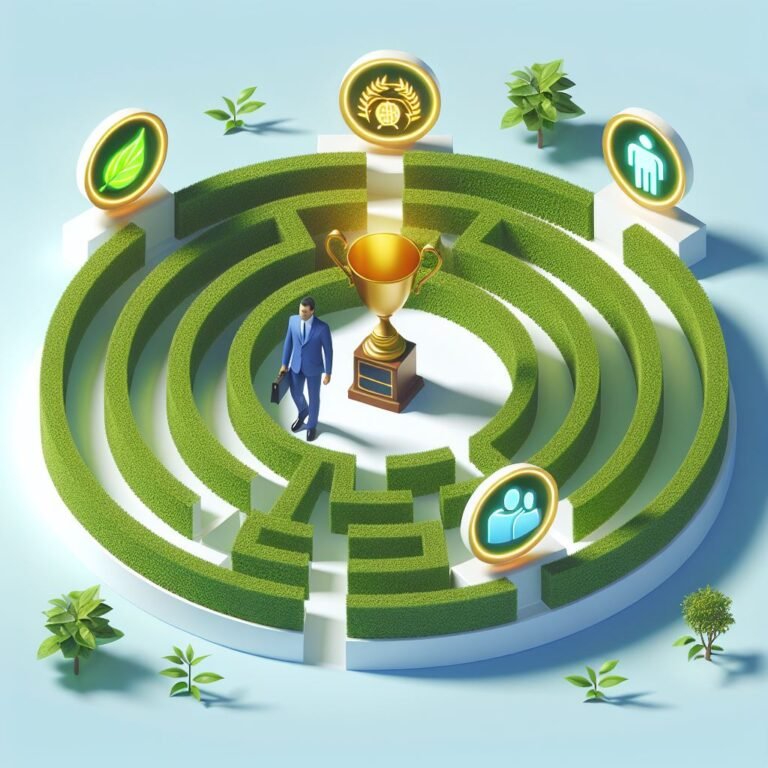ESG Opportunities: A Comprehensive Guide to Sustainable Business Transformation
Ever wonder how your business could make a real difference in the world while driving profitability? Welcome to the world of Environmental, Social, and Governance opportunities, the so-called ESG.
Today, ESG is fast becoming a core tenet of business success, versus just another buzzword, for businesses operating in the dynamic corporate world.
Think of ESG as the blueprint for your business’s lasting positive impact. Whether a seasoned executive or just at the threshold of your sustainability journey, understanding ESG opportunities will unlock doors to innovation, growth, and significant change.
From sustainable initiatives to governance frameworks, this comprehensive guide will walk you through all the exciting possibilities available within the ESG space.
If that sounds good to you, let’s dive right into how your organization can set up for success while making a positive difference.
The Exponential Growth of ESG Investments
The numbers don’t lie, ESG opportunities are seeing unprecedented growth. By 2026, ESG-related investments are projected to reach $33.9 trillion globally. That’s not just a trend; it’s a fundamental shift in how business and investment decisions are made.
What’s more telling, 90% of S&P 500 companies now do ESG reports. This is not about large corporations checking boxes; this is about businesses of all sizes recognizing that transparency in environmental, social, and governance practices is no longer optional.
The Business Case for Finding ESG Opportunities
Let’s talk about real impact. Companies that are leading the pack in ESG performance aren’t just doing good, they’re doing well.
For example, these organizations have a 27% narrower gender pay gap, proving that commitment to ESG principles translates into tangible workplace improvements.
The opportunities extend far beyond workplace equality. The global circular economy market, a key component of ESG initiatives, is projected to reach approximately $5.2 trillion by 2027. This represents enormous potential for businesses willing to innovate and adapt.
Perhaps most telling is the attitude of young investors. Those holding more than $250,000 in wealth have expressed willingness to give up 14% of their wealth to advance ESG issues.
This is a fundamental shift in how the next generation views the relationship between business and social responsibility.
At the core of these efforts is sustainable value creation, which goes beyond short-term profits to generate long-term benefits for businesses, stakeholders, and society.
The Increasing Costs of ESG Reporting
As attractive as the opportunities are, consider what investment is needed. Climate-related disclosure activities cost $677,000 annually on average for corporations in the U.S., meaning the complexity of ESG reporting and its growing importance are reflected in this key investment.
Not a cost per se, but an investment for the future of your company, proper reporting of ESG opportunities has the potential to build stakeholders’ trust, attract new investors, and help define areas for operational improvement.
Strategies for Integrating ESG into Business Operations
ESG implementation has to be holistic and strategic, far beyond superficial changes.
Detailed energy management is the first imperative-a thorough energy and sustainability audit would need to be carried out using advanced diagnostic tools that offer a roadmap for process efficiency over many years.
Similarly, other sophisticated technologies, such as smart building systems and on-site renewable energy generation, should be considered in relation to innovative incentive programs promoting energy-conscious behavior among the staff.
Sustainable resource optimization is another important dimension of ESG integration. Organizations need to develop business models that go beyond the traditional linear model of production and toward circular economy business models.
It entails zero-waste manufacturing, closed-loop supply chain systems, and strategic investment in recycling and upcycling technologies. Product design becomes a key lever for organizations in reimaging their products to be sustainable at the end of life.
Technology and innovation lie at the heart of modern ESG strategies. Progressive organizations harness the power of AI and machine learning in creating sophisticated analytics on sustainability.

Innovation labs set up by companies to drive sustainable solutions will result in technological breakthroughs.
Digital platforms for environmental impact tracking and employee-driven innovation in sustainability programs inculcate a culture of continuous improvement and technological adaptation.
Operational transformation means that fundamental reimagining of business processes needs to take place.
Sustainability has to be core rather than an afterthought: building holistic carbon reduction strategies, renewable energy procurement plans, sustainable logistics network designs, and integrating sustainability metrics into performance appraisals.
This would be a holistic approach wherein ESG considerations are woven into the very fabric of organizational decision-making.
Aligning ESG with Corporate Social Responsibility
Workforce development has gone beyond the traditional human resource concepts. Organizations today introduce a holistic wellness program for their employees, which encompasses their mental, physical, and professional well-being.
This comprehensive approach includes a mental health support system, continuous learning platforms, inclusive career progression frameworks, and flexible work arrangements that actually respect work-life balance.
Community engagement morphs from episodic charitable actions into fully executed strategic partnership programs.
It creates profound and substantive connections with local communities by establishing skills-based volunteering opportunities, economic development initiatives, sound community needs assessments, and impact measurement methodologies that are highly transparent.
These approaches reframe corporate citizenship as core to organizational strategy, rather than as a tangential activity.
Diversity, equity, and inclusion become systematic organizational commitments. Beyond simple recruitment quotas, companies develop robust diversity strategies that include unconscious bias training, comprehensive mentorship programs, sponsorship initiatives, rigorous pay equity review processes, and leadership development programs designed to create truly inclusive organizational cultures.
Sustainable supply chain management is complex, multilayered. That is why organizations have a wide-ranging supplier sustainability assessment, collaborative improvement programs, and ethical sourcing guidelines in place and establish a clear channel for communication.
Most importantly, these approaches also support the road to sustainability transformation journeys for small and diverse suppliers.
Ethical Considerations in ESG Opportunities
It would transform corporate governance from a compliance exercise into an advanced ethics framework: independent ethics oversight committees, comprehensive whistleblower protection mechanisms, clear conflict of interest policies, and ensuring board-level sustainability expertise became standard practice.
The goal is to create organizational structures that promote ethical behavior innately.
Regulatory compliance becomes proactive rather than reactive. Not only do organizations meet the minimum requirements, but they develop adaptive strategies that will meet and exceed regulatory expectations.
This involves developing robust monitoring systems, continuous legal and ethical training, and active participation in the development of industry-wide ethical standards.
Anti-corruption work demands holistic and globally consistent approaches, ranging from developing advanced policies that go beyond compliance, transparent financial reporting mechanisms, stringent due diligence processes, to setting up global ethical standards of business conduct sensitive to diverse cultural contexts.
Human rights and labor practices become a critical consideration across global operations. Organizations would have to implement comprehensive supply chain human rights assessments, develop sophisticated grievance and remediation mechanisms, support initiatives on the living wage, and develop protection frameworks that make workers’ rights and safety at work certain in all operational contexts.
Embracing the Sustainable Development Goals
Strategic SDG alignment requires more than superficial reporting: organizations conduct thorough impact assessments, develop targeted contribution strategies, and create measurable performance indicators directly linked to the accomplishment of sustainable development goals.
That means placing SDG goals at the core of corporate strategy and reporting on transparent, meaningful progress.
Collaborative ecosystem development is a key strategy. Organisations engage in multi-stakeholder sustainability initiatives, support crosssector partnerships, develop knowledge-sharing platforms, invest in focused research and innovation, and create collaborative networks beyond traditional organisational boundaries.
Conclusion
The journey to ESG excellence is complex and an added opportunity. As we explored, the potential rewards are financial and great for society as well. Whether you are just starting or looking for ways to enhance existing initiatives, there is no better time to act.
Future Trends
The ESG landscape is still changing very fast. The future of ESG opportunities encompasses more biodiversity awareness, AI-driven analytics for ESG, blockchain in ensuring supply chain transparency, expanded stakeholder capitalism, and stricter regulations.
Remember, every single step toward sustainability counts. Now, what will your company’s ESG story read?







